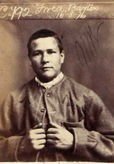Frederick George Barton alias Lord Barrington
Aka Lord Barrington 1859 - 1950
My great, great uncle, Frederick George Barton was born in Tunbridge Wells on 7th March 1859. His father John Barton was a 'fly driver' (coachman), his mother was Catherine Cramp. He had a sister Elizabeth 'Lizzie' Barton who is my great, great grandmother. The family were very poor. They lived in Hervey Town a poor neighbourhood in the Calverley Road area.
At the age of 7 years Frederick set fire to some gorse on the common near his home and was ordered to be whipped by the local Magistrate. At the age of 12 years Frederick was sent to Redhill Reformatory in Reigate for 5 years for embezzlement. He later absconded from the Reformatory and returned to Tunbridge Wells aged 17 years. He was given a job by a Reverend Coote and was subsequently repaid by Frederick committing a burglary at his home. Frederick went to Yorkshire where he worked for a travelling salesman of watches, he stole a watch from this employer and spent a month in prison on hard labour. He then returned to Tunbridge Wells in 1875, worked again for Reverend Coote before once again stealing jewellery and decamping to London. In 1876 Frederick was once again in Tonbridge where he burgled a house belonging to a Mr Hedlam. He stole some Railway bonds and other items before returning to London. He was arrested by Edmund Reid, a policeman who later became famous for his investigation of the 'Jack the Ripper' murders in 1881. Frederick was found guilty of burglary and sent to Portsmouth prison for a term of 10 years.
After 6 years Frederick was released on a fake pardon with the help of a man named Austin Biron Bidwell (an American fraudster who robbed the Bank of England in 1873).. In September 1880 Frederick had joined the British Army and was based at Chatham Barracks. An officer (Lieutenant Roper) was murdered during Frederick's time there and it was later believed that he was involved, but there is no firm evidence of this. While at Chatham Frederick once again committed burglary at a house and in 1881 was found guilty and sentenced to 10 years. On this occasion he served his time and in 1889 he was released from prison.
He then left England for America via Canada. He spent some time in Colorado Springs using the name 'Captain Calthorpe Dealy' of the Coldstream Guards. He worked his way into local society and also worked as a journalist using the name 'Nevill Barton'. He travelled to New York where he met and married a lady named Celestine Miller whose father had left her quite wealthy. He told Celestine that he was a Lord and had an estate in England. After their marriage they returned to England where he once again committed burglary at various houses and was once again found guilty and sent to prison. His wife returned to New York with their baby daughter.
In 1902 Frederick, now 45 years old, was released from prison and headed once more to America where he met and married (bigamously) a lady named Margaret Rafferty, who he deserted on their honeymoon, taking all her possessions with him. A few weeks later Frederick was in St Louis where he met and married (again bigamously) a young lady named Grace Cochrane who also thought he was Lord Barrington. Grace's family found out that Frederick was not a member of the aristocracy and after a fist fight with her brother Frederick ended up in the local jail. Once released he became friends with a man named James McCann who had inherited money from his father, he owned a hotel in St Louis and Frederick stayed with him there until June 1903, where Frederick lured McCann out to a remote area and murdered him.
Frederick returned to the hotel the next day and stayed there until McCann's body was discovered and he was arrested. He was put on trial, found guilty and sentenced to hang. Various appeals followed over the next couple of years and Frederick's death sentence was commuted to life imprisonment. He was released in December 1918 and was supposed to have been deported back to England. He disappeared before this could happen and it is known that he returned to England at some point as there is another (bigamous) marriage in 1920 to a lady in Eastbourne named May Haffenden. Later in 1920 he returned to New York looking for his daughter from his first marriage. He seemed to be unaware that she had died in 1913. He then travelled to North Carolina where he married again, a lady named Monterey MacIntosh. The marriage lasted for 2 months before Monterey committed suicide. At this point Frederick was using the name 'Frederick Augustus Hastings Seymour' and stated that he was a Major in the Army (retired), had received the Victoria Cross after seeing action in the Boer War (untrue).
Frederick's last marriage was in 1923 to a lady named Olive Keep in Florida. Once again he departed shortly after the marriage and was not heard of until he collapsed in a street in 1938, was taken to hospital and his story was revealed. He was found to not have a valid passport so was deported back to England and back to Tunbridge Wells where he lived the remainder of his life as 'Major Frederick Augustus Hastings Seymour' and became involved in the local branch of the YMCA. He died in Hospital on 22nd January 1950 at the age of 92 years, although a local obituary gave his age as 82 and stated that he was a veteran of the Boer War. He is buried in Hawkenbury Cemetery under the name of Major Frederick Augustus Hastings Seymour, but his grave is not marked with a headstone. A member of the YMCA arranged the funeral as Frederick was not in contact with his family.
Written by Audrey Holt 2024





